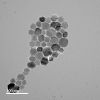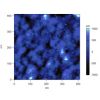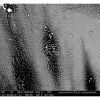Nanomaterials and Health group

Transmission Electron Microscopy (TEM) image of the core/shell of a superparamagnetic nanoparticle

Atomic Force Microscopy (AFM) image of fibronectin grafted onto a membrane

Scanning Electron Microscopy (SEM) image of a stem cell that had developed on a surface activated by polyelectrolyte multilayers
Last publications
- Artificial intelligence in revolutionizing orthodontic practice
Paul Fawaz, Patrick El Sayegh, Bart Vande Vannet
World Journal of Methodology, 2025, 15 (3), ⟨10.5662/wjm.v15.i3.100598⟩ - Micropatterning of Glass Substrates Using Electron‐Beam Lithography for Morphological Analysis of Human Umbilical Vein Endothelial Cells
Daniele Pedroni, Caroline Gaucher, Demba Ba, Laurent Badie, Isabelle Raeth-Fries, Halima Alem
Advanced Engineering Materials, 2025, ⟨10.1002/adem.202500862⟩ - Porous nitrogen-doped TiO2/graphene oxide derived from H2N-MIL-125(Ti)/graphene oxide composites as highly efficient visible light active photocatalysts for the degradation of dyes and carbamazepine
Askar Bakhadur, Halima Alem, Vincent Carré, Thomas Gries, Lavinia Balan, Jean-Louis Cantin, Ghouti Medjahdi, Zhandos Orazov, Bolat Uralbekov, Raphaël Schneider
Applied Surface Science, 2025, 714, pp.164466. ⟨10.1016/j.apsusc.2025.164466⟩
Presentation
The state of knowledge of the effects of micro/nanometric particles in air pollution and those developed for cancer therapy has led to fears about the effects of man-made nanoparticles on health.
However, few reliable data, i.e. reproduced by different research groups, are currently available in this field.
The group's project aims for a systemic and transversal approach, synonymous with multidisciplinarity.
Its approach is stimulated by the ability to synthesize innovative nanomaterials designed to interact with living organisms.
Furthermore, the members have know-how in the control of risks for humans and their environment.
The group applies the following 3 study paradigms in its work:
- Safe by Process for the development and implementation of nano-objects and nanomaterials
- Safe by Design that covers all aspects of the life cycle of the nano-product including recycling and end-of-cycle disposal
- Quantitative Structure Activity Relationship to predict the toxicity of any type of newly synthesised nanomaterial
Research topics
Development of nanoparticles for cancer therapy and testing their effectiveness ex-vivo
Different applications are targeted in the fields of cancer therapy or biofilm growth:
- Superparamagnetic core/shell nanoparticles for the combination of hyperthermia and drug release (Grand-Est Region, IUF Project)
- Organs on a chip enabling the growth and differentiation of cancer cells (IUF project)
- Anti-bacterial surfaces or, on the contrary, surfaces that promote the development of bacterial bio-films
Projects:
- ICEEL BioNanoSurf (2015-2019)
- LUE Mirabelle+ CREOL (2019-2021)
- IUF (2019-2024)
Theses:
- Enaam Jamal Al Dine (2013-2017)
- Zied Ferjaoui (2016-2020)
- Elena Yunda (2016-2019)
- Dounia Louaguef (2019-…)
Articles:
- Doxorubicin Loaded Thermo-responsive Superparamagnetic Nanocarriers for Controlled Drug Delivery and Magnetic Hyperthermia Applications, Ferjaoui Z, et al., , ACS Appl. Mater. Interfaces 2019, 11, 30610-30620.
- Chemical Functionalization of the Zinc Selenide Surface and Its Impact on Lactobacillus rhamnosus GG Biofilms, Yunda E, et al. ACS Appl. Mater. Interfaces 2020, 12, 13, 14933-14945
Assessment of the hazards of nanomaterials through in-vitro and in-silicio studies, using biological, biochemical and toxicological expertise
- Measurement of the internalization, biodegradation or biopersistence of nanomaterials in cells
- Determination of their molecular target by the analysis of major macromolecules: mRNA, DNA and proteins
- Study of their interaction with different cells which play a barrier role: skin, intestinal, pulmonary cells, and macrophages
- In detailed determination of cell fate (growth, differentiation, apoptosis, autophagy) and the mechanism of action of these nanomaterials on living organisms using the tools of mechanistic toxicology
Project:
EU H2020 SmartSmartNanoTox (2016-2020)
Theses:
- Sara Nahle (2016-2019)
- Zahra Doumandji (2016-2019)
Articles:
- Genes expression profiling of alveolar macrophages exposed to non-functionalized, anionic and cationic multi-walled carbon nanotubes shows three different mechanisms of toxicit, Nahle S, et al. J Nanobiotechnology. 2020, 18(1), 36.
- Protein and lipid homeostasis altered in rat macrophages after exposure to metallic oxide nanoparticles, Doumandji Z, et al. Cell Biol Toxicol. 2020, 36(1), 65-82.
Know-how
Chemical synthesis on suitable surfaces
Polymerisation initiated from the surface of thermo-responsive polymers or co-polymers for the purpose of grafting
Deposition of multilayers of synthetic or biomass-derived polyelectrolytes
Self-assembly of monolayers by silane and thiol chemistry
Evaluation of the consequences of the interactions of nanomaterials with living organisms.
These are modelled in monolayer cell culture, or co-culture exposed in a liquid vein or by aerosols
Measurement of the biopersistence of nanomaterials
Measurement of all types of effects on the intermediate (mRNA) and final (proteins) phenotype of exposed cells including:
- oxidative stress
- cellular overload
- immunotoxicity
- cell fate (differentiation, autophagy, apoptosis, necrosis)
Members
CNRS researchers
Professors, assistant professors
- Halima ALEM-MARCHAND
- Luc FERRARI
- Olivier JOUBERT
- Clémence MÉAUSOONE
- Bart VANDE VANNET
- Mohamed ZAIOU
Technical and support staff
- Cyril NOIREL
PhD students
- Cyprien BERTHELEMY
- Siwar HACHANA
- Agathe LEMEE
- Lucas MEYER SYLLOS
- Daniele PEDRONI
- Nicolas POTIER
- Adel TRABOULSI
Publications
Contact
Head of the group
Olivier JOUBERT
olivier.joubert@univ-lorraine.fr
+33 (0) 3 72 74 26 94
Nancy-Artem
Institut Jean Lamour
Campus Artem
2 allée André Guinier - BP 50840
54011 NANCY Cedex
